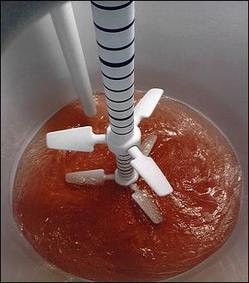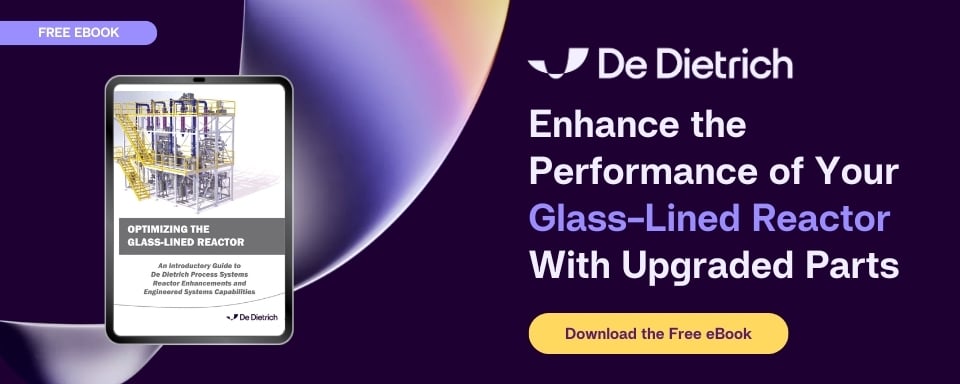Agitator Options for Glass-Lined Reactors
 “Are we looking to increase yield or improve batch time? Do we need to be concerned with low-level mixing? Should we get single or multiple tiers? And what blades will work best for our process?!” These are the questions that can be overheard when a process engineer is frantically pacing around his cubicle, mulling over the design options for a new mixing system. Okay, maybe we’re being a bit dramatic, or perhaps the engineer in our scenario is agitated about something else (no pun intended), but our point is that considerable thought needs to go into picking an agitation system.
“Are we looking to increase yield or improve batch time? Do we need to be concerned with low-level mixing? Should we get single or multiple tiers? And what blades will work best for our process?!” These are the questions that can be overheard when a process engineer is frantically pacing around his cubicle, mulling over the design options for a new mixing system. Okay, maybe we’re being a bit dramatic, or perhaps the engineer in our scenario is agitated about something else (no pun intended), but our point is that considerable thought needs to go into picking an agitation system.
Selecting and fitting the correct agitator for your glass-lined vessel batch process is extremely important for the optimization of your reactor performance. The duty of the agitator must first be assessed, followed by the evaluation of flow pattern and regime as well as any special requirements that need to be taken into consideration, such as blending time, product concentration, and viscosity. Based on the relevant factors that comprise your unique process, an agitator design that matches the requirements of the application can be determined.
Process Objectives
The first step to picking out the appropriate agitator is to answer, “What is the most important job for your agitator to accomplish?” In many situations there are multiple objectives that need to be carried out simultaneously. Here is a list of the common responses to this question:- Suspension
- Dissolution/Crystallization
- Extraction Liquid/Solid
- Chemical Reaction
- Emulsion
- Blending
- Extraction Liquid-Liquid
- Gas Sparging
- Dilution
- Neutralization
- Dispersion
- Heat Transfer
- Absorption
- Fermentation
- Circulation
- Coagulation
Once these objectives have been determined, you can prioritize your list to identify their level of importance.
Flow Pattern
Determining the desired flow pattern of the material in your reactor is dependent on your agitation objectives. There are two types of flow patterns that can be created – axial flow and radial flow. They are clearly illustrated in the figures below:
Figure 1. Axial Flow Figure 2. Radial Flow


In axial flow, the most common mode of operation, the agitator pumps down the axis of the vessel and up the wall (see figure 1). This flow is designed to produce high flow to power ratio. Agitators that produce this movement are typically run at a relatively high rotational speed and are suitable for applications that require high product flow and low turbulent energy. Suspending settling solid particles and low viscosity bulk blending are examples of processes that work well utilizing axial flow.
Radial flow propels liquid outward from the agitator blade and revolves around the vessel axis, producing upper and lower circulation loops (see figure 2). While axial flow can be carried out with or without the use of a baffle, radial flow should always be operated with baffles to enable circulation between the top and bottom circular flows that are created from this flow pattern. Radial flow is ideal for de-agglomerating solids, dispersion and emulsion.
Flow Regime
Once you have diagnosed your ideal flow pattern for your process, the next step is to determine what flow regime will complement it. Laminar flow occurs when fluid flow has no cross currents and maintains a streamlined, parallel movement between its layers (figure 3). The motion of the particles in a laminar flowing liquid is very methodical, making this type of flow regime appropriate for crystallization and other processes that involve delicate particles. Conversely, a turbulent flow regime (figure 4) is characterized by sudden property changes which cause disorder to the particles. This can be caused by a variety of changes such as a rapid fluctuation of pressure and velocity. An agitator that promotes dispersion and heat transfer use turbulent flow.
Figure 3. Laminar Flow Figure 4. Turbulent Flow


Agitator Design
Glass-lined vessel agitator designs fall under two main categories: one-piece construction agitators and multiple-piece agitators (the latter of these will be referred to as GlasLock agitators in this article, but it should be noted that other glass-lined equipment manufacturers may make a similar product using a slightly different technology).
One-piece construction agitators are available in impeller, turbine, anchor and frame arrangements. Many customers prefer this traditional style agitator and there are numerous applications in which this design is still sufficient, however, it is less significant nowadays due to more advanced agitator technologies. One-piece agitators have a restricted field of application because they need a large opening to be installed, require mandatory dismantling of the drive for any maintenance, and (depending on the application) can sometimes encounter additional issues including sealing problems and difficulty cleaning.
GlasLock agitators maximize process flexibility by allowing blades to be installed, removed, and changed to various pitches, depending on what works best for the application at hand. This feature is advantageous from a maintenance perspective as well because individual blades can be replaced if they become damaged rather than having to remove and replace the entire agitator (and consequently don’t require the mechanical seal to be dismantled minimizing downtime). While additional headroom is needed for installation, GlasLock blades are especially ideal for fitting through the manway of a closed-welded GL reactor, and their properties are beneficial in CTJ and SA reactor series as well. The blade designs available in the GlasLock range include pitch blade turbine (which can be set at 30, 45, 60 and 90 angles depending on your process objective), hydrofoil, Rushton turbine, trapezoidal, OptiFoil (a combination of the hydrofoil and trapezoidal designs), and breaker bar. Generally speaking, the GlasLock line of agitators improves product yield and quality, reduces batch time and cost, and improves heat transfer efficiency by up to 30%.
As you can see, there is a lot to consider when selecting a mixing system for your process. Still not sure what agitator is right for your application? It’s often not so cut and dry, so this handy Agitator Comparison Chart is a great reference that provides a side by side comparison of the various types of agitators available and will give you more insight into the advantages of each blade design.
If you have a new process, problems with your current mixing system, or are simply looking to optimize the performance of an existing process, then we can help! By filling out and submitting the Agitation Simulation Questionnaire, we’ll be able to provide you with a simulation to demonstrate how your process can be improved.
To see our GlasLock blades in action and learn about the other enhancements available for glass-lined reactors, watch our animation “Optimizing the Glass-Lined Reactor”:
